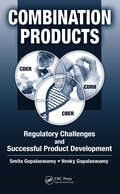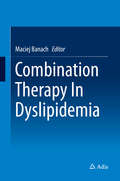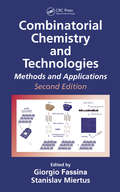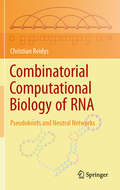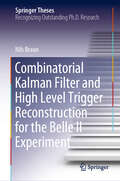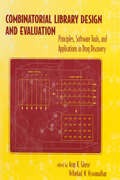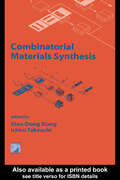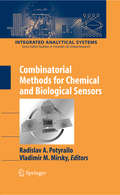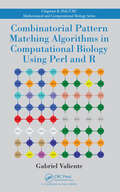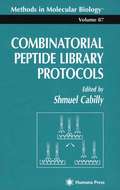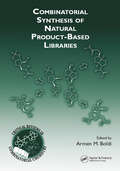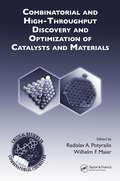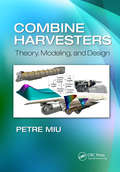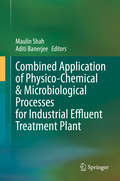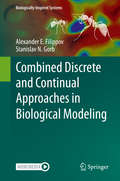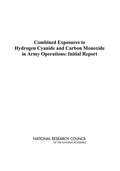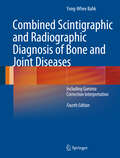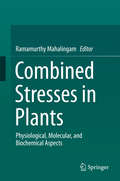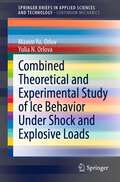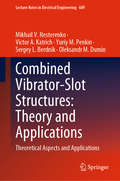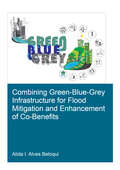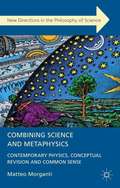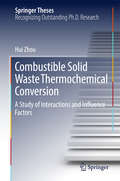- Table View
- List View
Combination Products: Regulatory Challenges and Successful Product Development
by Venky Gopalaswamy Smita GopalaswamyThe field of combination product development (products born of the integration of medical devices, biologics, and drugs) is so new that, while literature abounds on each part individually, there are very few publications, including FDA documents, available concerning the unique challenges posed by this nascent but fast-growing area. Providing
Combination Therapy In Dyslipidemia
by Maciej BanachComprising contributions from leading lipidologists from around the world, this book presents the latest and most comprehensive knowledge on the different options for combination therapy of dyslipidemia and includes discussion of future therapies that are currently in late stages of clinical evaluation. Dyslipidemia is a leading cause of cardiovascular morbidity and mortality and most patients with this condition fail to achieve adequate control of their serum lipid levels with monotherapy. However, recent US and European guideline recommendations, based on randomized, controlled trials, fail to discuss combination therapy options for patients with dyslipidemia. Statins remain the mainstay of drug therapy for hyperlipidemia and chapters in this book specifically examine the role of add-on therapy with different agents modulating the different lipid fractions in the blood, e. g. bile acid sequestrants, fibric acid derivatives (fibrates), omega-3 fatty acids (fish oils), inhibitors of Niemann-Pick C1 like 1 (NPC1L1) protein, cholesteryl ester transfer protein (CETP), apolipoprotein B-100 and microsomal triglyceride transfer protein (MTP) and the emerging proprotein convertase subtilisin/kexin type 9 (PCSK9) inhibitors. There is additional discussion of the role of non-drug therapy options such as nutraceuticals, functional foods and lipoprotein apheresis. The book also discusses the combination of antihypertensive drugs with lipid-lowering drugs in the management of cardiovascular risk in patents with dyslipidemia.
Combinatorial Aspects of Scattering Amplitudes: Amplituhedra, T-duality, and Cluster Algebras (Springer Theses)
by Matteo ParisiThis book is a significant contribution within and across High Energy Physics and Algebraic Combinatorics. It is at the forefront of the recent paradigm shift according to which physical observables emerge from geometry and combinatorics. It is the first book on the amplituhedron, which encodes the scattering amplitudes of N=4 Yang-Mills theory, a cousin of the theory of strong interactions of quarks and gluons. Amplituhedra are generalizations of polytopes inside the Grassmannian, and they build on the theory of total positivity and oriented matroids. This book unveils many new combinatorial structures of the amplituhedron and introduces a new important related object, the momentum amplituhedron. Moreover, the work pioneers the connection between amplituhedra, cluster algebras and tropical geometry. Combining extensive introductions with proofs and examples, it is a valuable resource for researchers investigating geometrical structures emerging from physics for some time to come.
Combinatorial Chemistry and Technologies: Methods and Applications, Second Edition
by Giorgio Fassina Stanislav MiertusSeveral books on the market cover combinatorial techniques, but they offer just a limited perspective of the field, focusing on selected aspects without examining all approaches and integrated technologies. Combinatorial Chemistry and Technologies: Methods and Applications answers the demand for a complete overview of the field, covering all of the
Combinatorial Computational Biology of RNA: Pseudoknots and Neutral Networks
by Christian ReidysIn this monograph, new combinatorial and computational approaches in the study of RNA structures are presented which enhance both mathematics and computational biology. It begins with an introductory chapter, which motivates and sets the background of this research. In the following chapter, all the concepts are systematically developed. The reader will find * integration of more than forty research papers covering topics like, RSK-algorithm, reflection principle, singularity analysis and random graph theory * systematic presentation of the theory of pseudo-knotted RNA structures including their generating function, uniform generation as well as central and discrete limit theorems * computational biology of pseudo-knotted RNA structures, including dynamic programming paradigms and a new folding algorithm * analysis of neutral networks of pseudo knotted RNA structures and their random graph theory, including neutral paths, giant components and connectivity All algorithms presented are freely available through springer.com and implemented in C. A proofs section at the end contains the necessary technicalities. This book will serve graduate students and researchers in the fields of discrete mathematics, mathematical and computational biology. It is suitable as a textbook for a graduate course in mathematical and computational biology.
Combinatorial Kalman Filter and High Level Trigger Reconstruction for the Belle II Experiment (Springer Theses)
by Nils BraunCombinatorial Kalman filters are a standard tool today for pattern recognition and charged particle reconstruction in high energy physics. In this thesis the implementation of the track finding software for the Belle II experiment and first studies on early Belle II data are presented. The track finding algorithm exploits novel concepts such as multivariate track quality estimates to form charged trajectory hypotheses combining information from the Belle II central drift chamber with the inner vertex sub-detectors. The eventual track candidates show an improvement in resolution on the parameters describing their spatial and momentum properties by up to a factor of seven over the former legacy implementation. The second part of the thesis documents a novel way to determine the collision event null time T0 and the implementation of optimisation steps in the online reconstruction code, which proved crucial in overcoming the high level trigger limitations.
Combinatorial Library Design and Evaluation: Principles, Software, Tools, and Applications in Drug Discovery
by Arup Ghose Vellerkad ViswanadhanThis text traces developments in rational drug discovery and combinatorial library design with contributions from 50 leading scientists in academia and industry who offer coverage of basic principles, design strategies, methodologies, software tools and algorithms, and applications. It outlines the fundamentals of pharmacophore modelling and 3D Qua
Combinatorial Library Methods and Protocols: Methods and Protocols (Methods in Molecular Biology #201)
by Lisa B. EnglishLisa English and a panel of expert chemical researchers have collected in Combinatorial Library Methods and Protocols a novel series of computational and laboratory methods for the design, synthesis, quality control, screening, and purification of just such combinatorial libraries. Here the reader will find cutting-edge techniques for the preparation of encoded combinatorial libraries, for the synthesis of DNA-binding polyamides, and for combinatorial receptors. There are also state-of-the-art methods for computational library design, quality control by mass spectrometry, and structure verification using 1D and 2D NMR.
Combinatorial Materials Synthesis
by Xiao-Dong Xiang Ichiro TakeuchiPioneered by the pharmaceutical industry and adapted for the purposes of materials science and engineering, the combinatorial method is now widely considered a watershed in the accelerated discovery, development, and optimization of new materials. Combinatorial Materials Synthesis reveals the gears behind combinatorial materials chemistry and thin-
Combinatorial Methods for Chemical and Biological Sensors (Integrated Analytical Systems)
by Vladimir M. Mirsky Radislav A. PotyrailoChemical sensors are in high demand for applications as varied as water pollution detection, medical diagnostics, and battlefield air analysis. Designing the next generation of sensors requires an interdisciplinary approach. The book provides a critical analysis of new opportunities in sensor materials research that have been opened up with the use of combinatorial and high-throughput technologies, with emphasis on experimental techniques. For a view of component selection with a more computational perspective, readers may refer to the complementary volume of Integrated Analytical Systems edited by M. Ryan et al., entitled "Computational Methods for Sensor Material Selection".
Combinatorial Pattern Matching Algorithms in Computational Biology Using Perl and R (Chapman & Hall/CRC Computational Biology Series)
by Gabriel ValienteEmphasizing the search for patterns within and between biological sequences, trees, and graphs, Combinatorial Pattern Matching Algorithms in Computational Biology Using Perl and R shows how combinatorial pattern matching algorithms can solve computational biology problems that arise in the analysis of genomic, transcriptomic, proteomic, metabolomic
Combinatorial Peptide Library Protocols (Methods in Molecular Biology #87)
by Shmuel CabillyA valuable collection of new and unique techniques for the construction and use of peptide libraries. These powerful methods include protocols for the chemical synthesis of peptide libraries, for constructing peptide libraries that are displayed on the surface of filamentous phage or bacteria, and for the rapid screening of these libraries for molecules with biospecific properties. Additional methods permit identifying specific enzyme substrates, investigating the recognition spectra of various binding proteins, epitope mapping, and identifying mimotopes. State-of-the-art techniques, combined with clear step-by-step instructions, make this book an essential tool in the selection of peptides suitable for drug development.
Combinatorial Synthesis of Natural Product-Based Libraries
by Armen M. BoldiTraditionally, the search for new compounds from natural products has been a time- and resource-intensive process. The recent application of combinatorial methods and high-throughput synthesis has allowed scientists to generate a range of new molecular structures from natural products and observe how they interact with biological targets. Combinato
Combinatorial and High-Throughput Discovery and Optimization of Catalysts and Materials (Critical Reviews in Combinatorial Chemistry)
by Radislav A. Potyrailo Wilhelm F. MaierThe development of parallel synthesis and high-throughput characterization tools offer scientists a time-efficient and cost-effective solution for accelerating traditional synthesis processes and developing the structure-property relationships of multiple materials under variable conditions. Written by renowned contributors to the field, Combina
Combine Harvesters: Theory, Modeling, and Design
by Petre MiuFrom Basic Fundamentals to Advanced Design ApplicationsA culmination of the author's more than 20 years of research efforts, academic papers, and lecture notes, Combine Harvesters: Theory, Modeling, and Design outlines the key concepts of combine harvester process theory and provides you with a complete and thorough understanding of combine harvest
Combined Application of Physico-Chemical & Microbiological Processes for Industrial Effluent Treatment Plant
by Aditi Banerjee Maulin ShahIn recent decades, scientific insight into the chemistry of water has increased enormously, leading to the development of advanced wastewater and water purification technologies. However, the quality of freshwater resources has continually deteriorated worldwide, both in industrialized and developing countries. Although traditional wastewater technologies focus on the removal of suspended solids, nutrients and bacteria, hundreds of organic pollutants occur in wastewater and urban surface waters. These new pollutants are synthetic or naturally occurring chemicals that are not often monitored in the environment but have the potential to enter the environment and cause known or suspected adverse ecological and / or human health effects. Collectively referred to as the "emerging contaminants," they are mostly derived from domestic use and occur in trace concentrations ranging from pico to micrograms per liter. Environmental contaminants are resistant to conventional wastewater treatment processes and most of them remain unaffected, leading to the contamination of the receiving water. As such, there is a need for advanced wastewater treatment process that is capable of removing environmental contaminants to ensure safe fresh water supplies. This book explains the biological and chemical wastewater treatment technologies. The biological wastewater treatment processes presented include: (1) bioremediation of wastewater such as aerobic and anaerobic treatment; (2) phytoremediation of wastewater using engineered wetlands, rhizofiltration, rhizodegradation, phytodegradation, phytoaccumulation, phytotransformation and hyperaccumulators; and (3) mycoremediation of wastewater. The chemical wastewater treatment processes discussed include chemical precipitation, ion exchange, neutralization, adsorption and disinfection. In addition, the book describes wastewater treatment plants in terms of plant size, layout and design as well as installation location. Also presenting the latest, innovative effluent water treatment processes, it is a valuable resource for biochemical and wastewater treatment engineers, environmental scientists and environmental microbiologists.
Combined Discrete and Continual Approaches in Biological Modelling (Biologically-Inspired Systems #16)
by Stanislav N. Gorb Alexander E. FilippovBasic laws of nature are rather simple, but observed biological structures and their dynamic behaviors are unbelievably complicated. This book is devoted to a study of this “strange” relationship by applying mathematical modeling to various structures and phenomena in biology, such as surface patterns, bioadhesion, locomotion, predator-prey behavior, seed dispersal, etc. and revealing a kind of self-organization in these phenomena. In spite of diversity of biological systems considered, two main questions are (1) what does self-organization in biology mean mathematically and (2) how one can apply this knowledge to generate new knowledge about behavior of particular biological system? We believe that this kind of “biomimetics” in computer will lead to better understanding of biological phenomena and possibly towards development of technical implications based on our modeling.
Combined Exposures to Hydrogen Cyanide and Carbon Monoxide in Army Operations: Initial Report
by National Research Council of the National AcademiesIn response to a request from the U.S. Army, a committee convened by the National Research Council (NRC) conducted the first in a sequence of studies evaluating the combined health effects of low-level exposure to two chemicals Army personnel are likely to be exposed to in firing tank weapons. The Army sought information on whether the two chemicals, hydrogen cyanide and carbon monoxide, result in similar health impacts and should be assessed together when establishing exposure limits. Based on a review of the scientific literature, the report finds that the biochemical health impacts of the chemicals are similar and that the Army's proposed approach to setting exposure limits is appropriate. Because previous research has focused on high exposures, this initial NRC report recommends that futher neurological studies at low concentrations of exposure to the chemicals be conducted.
Combined Scintigraphic and Radiographic Diagnosis of Bone and Joint Diseases: Including Gamma Correction Interpretation
by Yong-Whee BahkIn this fourth edition of Combined Scintigraphic and Radiographic Diagnosis of Bone and Joint Diseases, the text has been thoroughly amended, updated, and partially rearranged to reflect the latest advances. In addition to discussing the role of pinhole imaging in the range of disorders previously covered, the new edition pays detailed attention to the novel diagnostic use of gamma correction pinhole bone scan in a broad spectrum of skeletal disorders. A large number of state of the art pinhole scans and corroborative CT, MRI, and/or ultrasound images are presented side by side. The book has been enlarged to encompass various new topics, including occult fractures; cervical sprain and whiplash trauma; bone marrow edema; microfractures of trabeculae; evident, gaping, and stress fractures; soft tissue diseases; and differential diagnosis. This new edition will be essential reading for practitioners and researchers in nuclear medicine, radiology, orthopedic surgery, and pathology.
Combined Stresses in Plants: Physiological, Molecular, and Biochemical Aspects
by Ramamurthy MahalingamThe unique responses of plants to combined stresses have been observed at physiological, biochemical, and molecular levels. This book provides an analysis of all three levels of change in various plants in response to different combinations of stresses. The text provides a general review of the combined stress paradigm, focuses on the impact of higher CO2 levels in combination with other stresses, examines drought stress in conjunction with other abiotic factors in different crop plants as well as the combination of biotic and abiotic factors, and discusses the impact of combined stresses in forest ecosystems. Written by experts in the field, Combined Stresses in Plants: Physiological, Molecular, and Biochemical Aspects is a valuable resource for scientists, graduate students, and post-doctoral fellows alike working in plant stresses.
Combined Theoretical and Experimental Study of Ice Behavior Under Shock and Explosive Loads (SpringerBriefs in Applied Sciences and Technology)
by Maxim Yu. Orlov Yulia N. OrlovaThe book presents theoretical and experimental studies of ice fracturing process during impact and explosion load. It shows how to obtain ice in natural and artificial conditions. The book summarizes the results of full-scale experiments for 5 years on undermining ice sheets with emulsion explosives. It presents an algorithm that simulates the process of fracturing of thick ice subjected to blast load, showing that the behavior of ice under impact and explosive loads can be described by a model of continuum mechanics. Qualitative and quantitative assessments of the ballistic perfomance of an ice cube after deep penetration low-velocity projectiles are reported in this book. Some pilot problems are formulated for a deeper understanding of the mechanics of ice fracturing during impact and explosion.
Combined Vibrator-Slot Structures: Theoretical Aspects and Applications (Lecture Notes in Electrical Engineering #689)
by Victor A. Katrich Yuriy M. Penkin Sergey L. Berdnik Mikhail V. Nesterenko Oleksandr M. DuminThe book presents solutions to a complex of internal and external problems of electromagnetics associated with the development of theory, construction of mathematical models and the development of rigorous methods for calculating the electrodynamic characteristics of combined vibrator-slot structures. The solutions of problems for determining the characteristics of impedance vibrator and slot radiators with arbitrary geometric and electrophysical parameters presented in the monograph were obtained within the framework of the unified methodological approach to construct asymptotic solutions of integral equations on currents and their systems. This approach made it possible to study a number of new combined vibrator-slot structures. The research results reveal the possibilities of using such structures as basic elements in the creation of modern antenna-waveguide devices operating in the ranges from meter to millimeter wavelengths, with new technical characteristics and functional purpose. The book is intended for senior and postgraduate students and researchers working in the fields of radiophysics, radio engineering and antenna-feeder design.The book covers the following topics:• excitation of electromagnetic waves in volumes with coordinate boundaries;• general issues of the theory of thin impedance vibrators and narrow slots in a spatial-frequency representation;• solution of current equations for isolated vibrator and slot scatterers;• combined radiating vibrator-slot structures in rectangular waveguide;• T-junctions of rectangular waveguides with vibrator-slot structures in coupling areas;• waveguide radiation of the combined vibrator-slot structures;• combined vibrator-slot structures located on a perfectly conducting sphere;• combined vibrator-slot Radiators in antenna arrays;• ultrawideband vibrator-slot structures;
Combining Green-Blue-Grey Infrastructure for Flood Mitigation and Enhancement of Co-Benfits (IHE Delft PhD Thesis Series)
by Alida I Alves BeloquiAn increment of urban flood risk in many areas around the globe is expected, accentuated due to climate change and urbanisation. Thus, appropriate flood risk management is crucial. Conventional approaches focus on grey infrastructure, which frequently do not address the root causes of risk. A change of paradigm is needed to develop effective adaptation strategies. Green-blue infrastructure (GBI) is a central concept to achieve adaptation to climate change. Its main strength is the ability to deliver multiple benefits. Although strong evidence exists demonstrating that GBI is a sustainable solution to reduce flooding, its adoption is still slow. Therefore, the objective of this research is to help decision-makers to adopt adaptation strategies to cope with flood risk while achieving other benefits. This study provides a framework which introduces co-benefits into decision-making for stormwater infrastructure planning. Besides, the multiple benefits are quantified and their impact on helping GBI implementation are evaluated. Finally, the effects of including co-benefits on the selection of flood mitigation strategies and the trade-offs among cost and benefits are assessed. This work contributes to enhance planning processes for flood mitigation combining green-blue-grey measures. It provides tools and knowledge to facilitate holistic decision-making, in order to ensure safe and liveable urban spaces for current and future conditions.
Combining Science And Metaphysics
by Matteo MorgantiOffering a new perspective on the debate concerning naturalism in philosophy, this book defends the autonomy of metaphysics while also making science centre stage. Three independent case studies provide a clear introduction to, and discussion of, key philosophical issues.
Combustible Solid Waste Thermochemical Conversion: A Study of Interactions and Influence Factors (Springer Theses)
by Hui ZhouThis book is written by Dr. Hui Zhou as a Ph. D. dissertation in Tsinghua University, China. It establishes the thermochemical characteristics of model compounds in combustible solid waste (CSW), and delineates the influence of different factors on the thermochemical characteristics and the influence interactions between model components have on the thermochemical characteristics. The works provide a theoretical basis for the clean and high-efficiency utilization of CSW as well as the basic knowledge for further understanding the thermochemical conversion mechanisms of complex fuels. Researchers and engineers in the field of thermal engineering and environmental engineering can benefit from the book.
